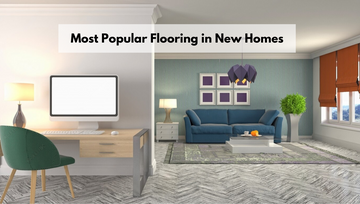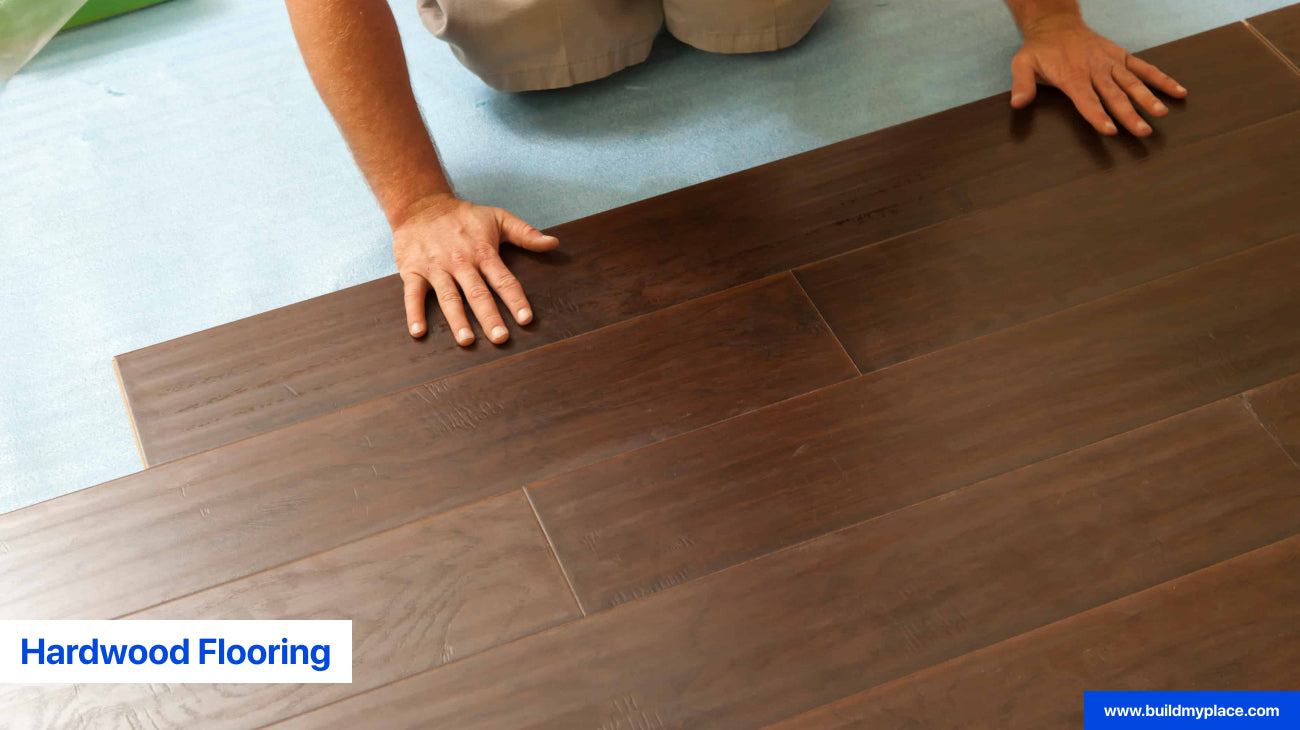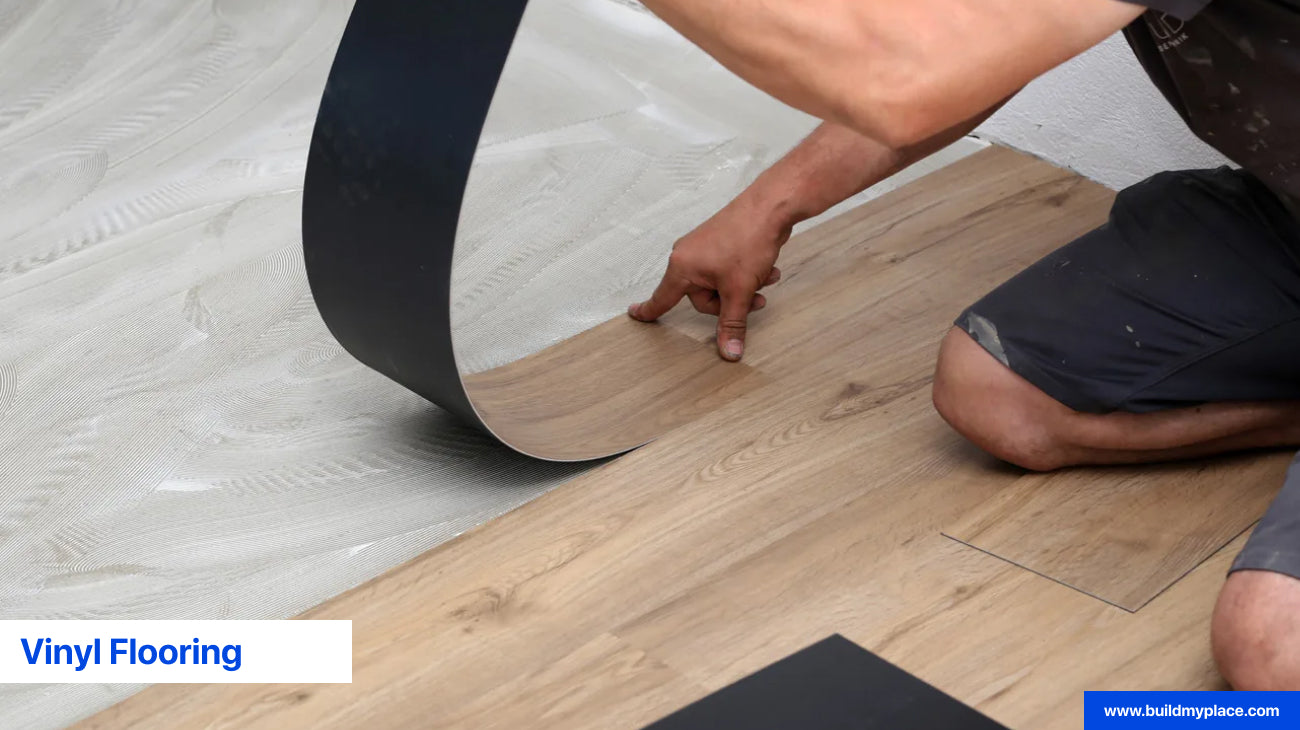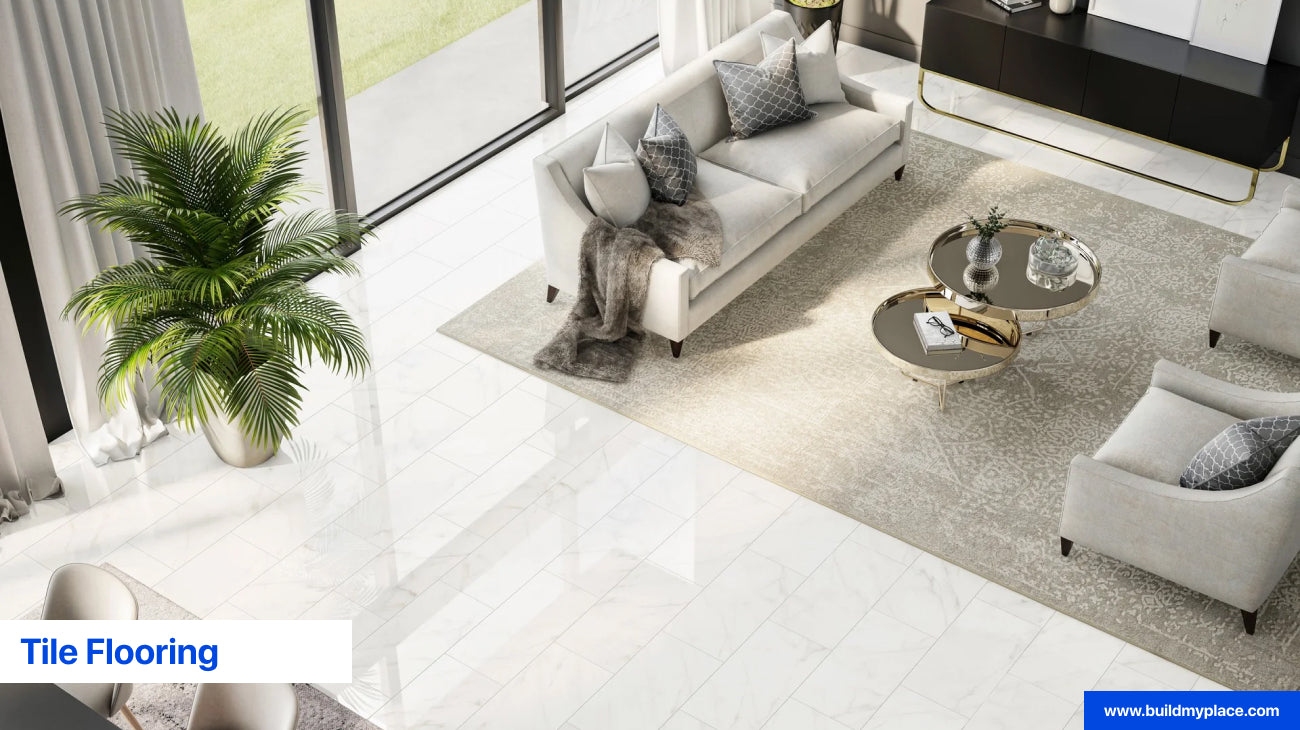Most Popular Flooring in New Homes
by Team BuildMyplace on Apr 22, 2024

You have to make a ton of selections while building or remodeling your ideal house. These considerations include searching for the most popular flooring in new homes and choosing the lighting fixtures, wall colors, and furniture types.
You may not think about it when you picture your ideal living area, but in real when we say that it sets the tone for everything else. Your home's beauty, comfort, and functionality are all conveyed via the flooring, which you can feel as soon as you walk in.
In the realm of flooring for new homes, what is now popular? Let's dig right in and examine the most well-liked choices that homeowners are smitten with, in the current housing industry.
1. Hardwood Flooring:

Real wood flooring, such as that found on oak or maple trees, is called hardwood flooring. Clients adore it for its longevity and timeless appearance. It is a well-liked choice for living spaces and bedrooms, as it can provide comfort in any space. Despite the fact that vinyl and laminate are comparatively cheaper options, their classic appeal renders the investment justified, irrespective of a small premium. They are among the most popular flooring in homes.
➣ Pros: Hardwood flooring is durable and beautiful for a long time. They are rather simple to clean and maintain, and they may significantly increase a home's value. They offer superior insulation as well.
➣ Cons: Hardwood flooring can be expensive to lay and susceptible to moisture deterioration, and scratches when not properly cared for. They could also require refinishing over the years.
➣ Average Cost: The total expense of flooring made from hardwood may vary depending on the type of timber used. But, on average, the flooring material ranges from $8 to $12 per square foot.
2. Laminate Flooring:

Laminates are synthetic types of flooring. They imitate the look of stone or hardwood. It is comparatively cheaper. Its popularity stems from its cost, resilience to stains and spills, and overall durability. Congested areas like hallways and kitchens are ideal for it. Its ability to mimic the look of hardwood without coming at a high cost is the reason for its growing appeal.
➣ Pros: Laminate flooring renders the look of stone, tile, or wood. It is less costly than hardwood. And, not only is it long-lasting, but it is also stain- and water-resistant.
➣ Cons: Although laminate is robust, severe blows and sharp objects can still cause damage to it. The visual authenticity of wood or other natural materials is also absent from it.
➣ Average Cost: Laminate flooring costs around $3 to $7 per square foot installed. This makes it a more budget-friendly option compared to hardwood.
3. Vinyl Flooring:

Vinyl flooring is made of PVC and other materials. It is available in a range of patterns, including wood and stone appearances. It is strong and resistant to water. Additionally, it is perfect for application in restrooms and kitchens. Vinyl is a preferred material as the most popular flooring in new homes because of its endurance and minimal maintenance. The demand for it is rising because of its low price and capacity to mimic the physical characteristics of more expensive elements. It is the best floor for a new home.
➣ Pros: Vinyl flooring is extraordinarily resilient and impervious to water making it ideal for places with frequent traffic like kitchens and showers. It comes in a wide range of hues and designs, a few of which even resemble real elements like stone or hardwood.
➣ Cons: Vinyl flooring is sturdy. But it can get bent and scuffed as time passes. The presence or absence of volatile organic compounds (VOCs) is based on the kind of vinyl used.
➣ Average Cost: Installing vinyl flooring typically costs between $2 and $5 per square foot. This makes it one of the most affordable choices for flooring known.
4. Carpet Flooring:

Carpet flooring is manufactured from strands like nylon or polyester. It is cozy and comfortable. Particularly in household areas and bedrooms, individuals adore it. It has acoustic benefits, too. It blocks out disturbances. It has a wide range of colors and surface textures.
Carpet is still an appealing option because of its comfort and cozy feel, even if hard surface flooring is becoming increasingly common. You can utilize it in areas where you prioritize comfort. It figures as the best flooring for home office, home theatre, or entertainment room.
➣ Pros: Carpet offers coziness, warmth, and sound absorption. It is simple to combine with any interior because it is available in a range of designs and colors. In comparison to alternative flooring solutions, carpet is very reasonably priced.
➣ Cons: The carpet is prone to stains and can harbor irritants such as canine fur and dirt. To keep it looking neat and hygienic, periodic vacuuming and expert washing are needed.
➣ Average Cost: contingent upon the design and workmanship, carpet installation may run anywhere from $3 to $8 per square foot.
5. Tile Flooring:

Tile flooring includes materials like ceramic, porcelain, and natural stone. These materials are known for their toughness and versatility. It's great for areas where moisture is common. The areas are bathrooms and kitchens. It’s additionally useful here because it's resistant to stains and wear. People like it for its durability and stylish look. However, it needs more upkeep compared to other types of tile flooring.
➣ Pros: Tile flooring is durable, water-resistant, and easy to clean. This makes it ideal for areas prone to moisture such as bathrooms and kitchens. It comes in a wide range of colors, patterns, and materials. The materials include ceramic, porcelain, and natural stone.
➣ Cons: Tile can be cold and hard underfoot. It may crack or chip if heavy objects are dropped on it. Grout lines can also be difficult to clean. These tiles may require periodic sealing to prevent staining.
➣ Average Cost: The cost of tile flooring varies depending on the material. The cost is also variable as per the complexity of the installation. It typically ranges from $5 to $10 per square foot.
What to consider when choosing flooring for your home?
Let's delve into the essentials to consider, ensuring your flooring selection aligns with your lifestyle, budget, and design vision.
1. Lifestyle and Usage
How you use your space should be your first consideration. There are differences in the number of people walking through and the extent of damage in different rooms. Hardwood flooring, for example, is perfect for living rooms. It has a classic appeal, and it’s sturdy. The best flooring for a home office will be different from that in the kitchen. Nevertheless, ceramic tile or waterproof vinyl can be more sensible options in high-moisture areas like kitchens or bathrooms.
2. Comfort and Maintenance
Consider the comfort level and maintenance requirements of different flooring options. Soft coverings like carpets offer warmth and cushioning. This makes them the most popular flooring in new homes, especially bedrooms. They do, however, require regular cleaning. Hard surfaces, such as laminate or tile, are easier to clean but might require rugs for added comfort in living spaces.
3. Health and Sustainability
Green flooring solutions are becoming progressively more common. They may reduce allergies and enhance overall human health and the surroundings. Such eco-friendly yet fashionable flooring may be manufactured from recyclable sources. Some recyclable flooring materials include bamboo and cork. Another way to boost the indoor air quality is to use low-VOC materials.
4. Installation and Longevity
Some flooring options, like floating vinyl planks or click-lock laminate, are designed for easy DIY installation. Doing the installation yourself can save on costs. However, complex installations or materials like natural stone may require professional assistance. Consider not only the upfront cost but also the long-term durability and potential for refinishing, especially with hardwood floors.
5. Budget
Costs associated with flooring investments might differ greatly depending on the material of choice, installation necessities, and life expectancy. The upfront price of hardwood floors may be higher, but their longevity can result in savings over time. Conversely, laminate or vinyl flooring provides a cost-effective alternative. It comes in many styles, some of which can mimic more expensive materials.
Wrapping Up!
We made sure to update you with the nitty-gritty of the most popular flooring in new homes. To design a place that is distinctly your own, spend plenty of time to do your due diligence, and be adventurous and not hesitant to try to mix & match different flooring materials for different areas of your house. And, for any flooring assistance, reach out to our experts at BuildMyPlace via video chat.
FREQUENTLY ASKED QUESTIONS
Q: Which flooring is best for high-traffic areas such as walkways and kitchens?
A: Robust flooring options, including tile, vinyl, and laminate, are great for heavily used areas. Because these substances are stain-, leak-, and wear-resistant, they are suitable for locations with frequent foot traffic.
Q: Which type of flooring is ideal for houses that welcome pets?
A: Vinyl is often recommended for dog homes because of its stain and scratch resistance and durability. Plus, a carpet that resists stains could be a smart option. However, regular cleaning and maintenance are necessary. Especially, if you want your flooring to keep the carpet at its best.
Q: Is hardwood flooring appropriate for wet areas such as bathrooms?
A: Bathrooms and other high-moisture locations shouldn't utilize floors made of hardwood. This is due to the fact that they can, over time, bend or split. Instead, because they are resistant to water, tile and vinyl are particularly appropriate for such types of situations.
Q: Which flooring alternative is the most cost-effective for a small budget?
A: Laminate flooring tends to be extremely cost-effective for people with a tight budget. It is fairly easy to set up. Plus, it provides the appearance of hardwood or tile at a lesser cost, resulting in savings on supplies and manpower.
Q: What are some ways to keep my carpeted flooring looking nice?
A: To keep carpets clean, routine sweeping and quick spillage cleaning are essential. Furthermore, by getting the rug cleaned by specialists every twelve to eighteen months, you can keep pests and deeply embedded filth out of the carpeting and maintain its long lifespan and attractiveness.




